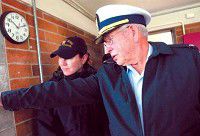Coast Guard honors rescue attempt in which seven people lost their lives 45 years ago
Published 4:00 pm Tuesday, January 17, 2006

- <I>LORI ASSA photo</I><BR>Albert Olsen, a retired officer-in-charge at U.S. Coast Guard Station Cape Disappointment, attended the commemorative ceremony Thursday morning. Olsen was acquainted with John Culp, a coxswain who lost his life on the Triumph.
ILWACO – Albert Olsen, a retired officer-in-charge at U.S. Coast Guard Station Cape Disappointment, attended the commemorative ceremony Thursday morning. Olsen was acquainted with John Culp, a coxswain who lost his life on the Triumph.
Daylight was fading when the crab boat Mermaid lost its rudder in the ocean near one of the deadliest river bars in the world.
As seas built to 30 feet and gale-force winds churned the surf off Peacock Spit at the mouth of the Columbia River, the U.S. Coast Guard attempted to rescue the drifting boat’s crew.
In the end, seven people lost their lives that night 45 years ago, five of them crew aboard the Coast Guard motor lifeboat Triumph.
The Coast Guard honored those victims Thursday at a ceremony commemorating the tragedy, in what may become an annual event through its 50th anniversary, said Boatswain’s Mate 1st Class Kyle Betts, launching the service at Station Cape Disappointment in Ilwaco.
“This is our job,” Betts said. “We go out so others may live.”
While it’s the nature of the job, sometimes nature takes its toll. The crew braving the storm that night “risked their lives,” he said. “Some paid the ultimate price.”
On Jan. 12, 1961, Cape Disappointment responded to the struggling Mermaid’s distress call, launching a 36-foot motor lifeboat and a 40-foot lifeboat to help, and requesting assistance from the former Coast Guard Station Point Adams, located in Hammond, Ore. until the 1960s. The Oregon station sent a 36-foot lifeboat and the 52-foot Triumph.
The crews faced deafening noise, heavy rain and gale-force winds, but “even in the extreme conditions, they remained steadfast,” Betts said. “This night, however, would not prove victorious for the Coast Guard … Mother Nature remains the most powerful force on the planet.”
Cape Disappointment’s 40-footer was the first boat to sink, capsized by a monster wave. The station’s 36-foot boat rescued the sunken boat’s crew and took them to the now-retired Columbia Lightship, but the rescuers’ boat sank soon after.
Meanwhile, the Point Adams boats attempted to hook towlines to the foundering 38-foot crabber. As the Triumph took a turn, a rogue wave slammed into it, capsizing the rare 52-foot lifeboat. While a 36-footer came close to success, another large breaker hit, snapping the towline and capsizing the Mermaid.
Five of six rescuers aboard the Triumph drowned, as did the Mermaid’s two-person crew.
The accident is one of many to have occurred at the Columbia River Bar, where strong outgoing tides clash with large incoming swells at the point where the river spills into the Pacific Ocean.
About 30 Coast Guard members, retirees and auxiliarists overlooked the treacherous site at Thursday’s memorial service, where the sunken 52-foot boat’s predecessor, Triumph II, plowed through the water with five other boats to lay a wreath in memory of the lives lost.
Unlike the original Triumph, the Triumph II is steel-hulled, one of four boats modeled after the Triumph and its sister boat, the Invincible.
Retired Capt. Albert Olsen was officer-in-charge at Cape Disappointment 50 years ago, and his father was on the original Triumph crew from 1935 to 1941.
Olsen knew John Culp, the coxswain controlling the 52-foot motor lifeboat during the 1961 tragedy.
The boat was tough, said the retired Coast Guardsman, who now lives in Rockaway Beach. He knew someone who at one point turned it upside down – on its beam’s end.
“She was really a good boat,” Olsen said. “When she was built it was state of the art … self-righting, with a hull framed with straight-grain oak ribs.”
Even so, a storm can do damage to the hardiest vessels. This week’s storm took a small toll on the newer Triumph.
Checking on a crab boat in the Pacific Ocean Wednesday, the lifeboat nailed a submerged object on its way back in; it also hit a crab pot. Rolled by the rough seas, it needed some work before making the commemoration’s wreath-laying journey.
But this time around, it was up to the commanding officer whether the boat even launched a rescue attempt.
Risk is a necessary part of working in the Coast Guard, but the agency now thinks harder about what those risks are.
“The crews that night were living with our old motto: You have to go out; you don’t have to come back,” Betts said. “Their legacy has changed the way we do things in the Coast Guard and here at Cape Disappointment.”




